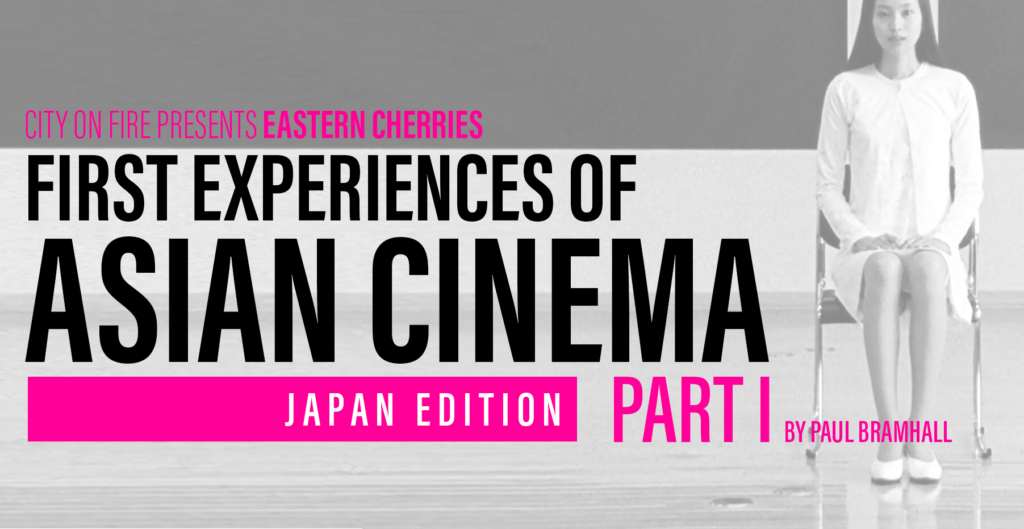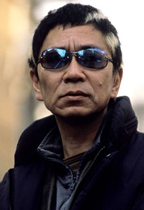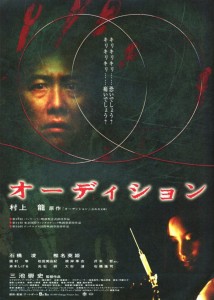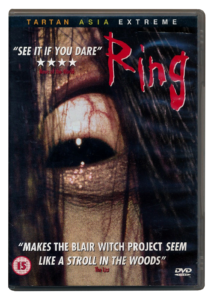
While it was Jet Li’s breakthrough role in Shaolin Temple that provided me with my first real taste of Asian cinema, my curiosity was piqued enough that I soon found myself exploring the realms beyond the kung fu genre. As a result, after binge watching the Hong Kong cinema classics for over a year, I gradually began consuming cinema from countries like Japan and Korea. My exposure to Japanese cinema in-particular had mainly been through the written word, with books I owned on Asian cinema inevitably raising names like Akira Kurosawa and Yasujiro Ozu somewhere along the way. While such instances of name dropping provided me with a peripheral awareness of the Land of the Rising Suns cinematic output, my first Japanese movie was about as far away from the works of Kurosawa and Ozu as humanly possible.
Being somewhat of a horror fan, it was while browsing the local newspaper in March of 2001 that I came across the cinema listings for the area, always wedged with a familiar regularity between the puzzle and sports pages. Each cinema usually had its own little box on the page, with the movies and times that were being shown listed within the frame. However, occasionally some movies were given their own little box, usually taking the form of a poster, and some small quote from a magazine such as Empire or Total Film. With my newfound curiosity for Asian cinema, I immediately noticed that one of the small pictures on this particular day was that of an Asian woman, and at the top of the picture were 5 stars – a small text underneath indicating that they were a rating from Empire magazine.
The picture was for a movie called Audition, and best of all, was at the time I had a subscription to Empire magazine, so it turned out I actually had the issue from which the review was taken. As I flicked through its pages, it turned out the writeup was of the kind that today would be referred to as a capsule review. Stuck in a small column on the side of one of its pages, the lack of dedicated space explained why I’d missed it upon my first browse of its pages, when it’d been delivered the week prior. The review didn’t give much away, other than it was an unsettling horror from a director called Takashi Miike, and that if it was showing on a cinema close to you, it would be a crime not to check it out.
Well, that was me sold. I immediately cross referenced the listings on the cinema closest to where I lived, and sure enough, it had a couple of screenings on the upcoming Saturday. One phone call later, any myself and my friend had our plans for the weekend sorted. It’s interesting to me now that, almost 20 years on if I know a Takashi Miike movie is being shown on a nearby cinema, you’ll most likely find me overbrimming with anticipation in the days prior. Back then though, with no prior knowledge of what we’d be seeing, in the intermediate days we gave Audition no further thought. It was simply that movie we were going to go and check out over the weekend.
I still clearly remember the day itself though. The screening was at 6:15pm, and I met my friend outside of the local Odeon multiplex (the same one we’d watched The Matrix a couple of years earlier) shortly before to shoot the breeze for a few minutes before going in. The plan was to watch the movie, then have a few beers in the pub next door. Skip forward a couple of hours later, and while we usually left the cinema declaring that whatever movie we’d watched was a masterpiece, or a steaming pile of crap, after Audition we both strolled out in a kind of speechless silence.
Whatever it was we’d just watched had been a cinematic experience, the kind of which neither of us had ever experienced before. We both had no real prior knowledge of what to expect, other than it was about a widowed man who, on the advice of his film producer friend, agrees to hold an audition for an upcoming movie, which in reality is in fact a ruse for him to find a new wife. On paper the plot already seemed somewhat outlandish, and the setup if anything resembled more of a comedy than anything indicating a horror.
Even onscreen, the opening third of Audition could well be argued to take on more of a comedic tone than anything close to resembling horror. But then, without the audience even noticing, the tone begins to shift gradually into a territory that, for someone who’d only been exposed to western style horror, feels increasingly uncomfortable and uneasy. The loud shock scares and build-up of music, so much a part of Hollywood horror, were completely missing from Audition, with scenes unapologetically playing out with no soundtrack accompaniment whatsoever. However rather than detracting from the experience, the silence in itself brought about a sense of creeping dread, the type of which it was impossible to put your finger on exactly what it was. As an entry point to Asian horror, I was hooked, even if at the time I didn’t yet know it.

Takashi Miike
It’s difficult to resist the urge to describe such scenes, even the smallest ones, that created that sense of foreboding, however I hold out the hope that there are still viewers out there that haven’t seen Audition, and for that reason I’d hate to reveal anything. In any case, regardless of my readings on the likes of Kurosawa and Ozu, Takashi Miike immediately became my favorite Japanese director (ok, so disregard the fact that I hadn’t seen the work of any others at this point), and Japanese horror became a genre I needed to see more of.
Watching the finale of Audition in the cinema is still as fresh in my mind today as it was back then. Despite it being a subtitled Japanese movie with minimum marketing, the cinema was about half full, which even today would be considered a good turn-out for such a production. Out of all the movies I’ve watched on the big screen both before and after Audition, it remains the only screening that I’ve witnessed people stand up and walk out of. For whatever reason, watching shocked audience members make their exit, somehow only added to the horror and excitement of watching the final scenes play out. The memory of gripping the armrest of the cinema seat, to the sound of “Kiri kiri kiri kiri kiri!”, is not one that can easily be forgotten, and I doubt it ever will.
As it happened, the UK distributor Tartan Video would release another Japanese horror movie on DVD, a little known title by the name of Ring, the same month, and its sequel a few months later. Naturally they were purchased almost as soon as they landed on high-street shelves. Looking back now, I was lucky enough to watch the likes of Audition and the original Ring trilogy with little to no knowledge or spoilers of what terror they contained, and for that I’m forever grateful. Would they be any less impactful if I’d known, or even had a hint, of how these movies ended? I’d argue most likely yes, however in the culture of social media and micro information sharing that we live in today, I’d say it may be almost impossible to not have some idea, which is a shame.
Ironically it was Ring more than Audition which went on to set the trend for Asian horror for most of the 00’s, with long haired pale skinned white ghosts appearing left right and centre. However as much of an influence as Hideo Nakata’s take on Sadako would have on the horror genre, it will always be Takashi Miike’s Asami that will linger in my memory as my entry point to Japanese cinema. It’s a film industry in recent times that frequently disappoints more than it entertains, but regardless of its current state, nothing can take away those glorious few years of the late 90’s and early 00’s, when for a brief shining moment, Japanese horror reigned supreme once more.
Read Eastern Cherries – First Experiences of Asian Cinema: Japan Edition Part II
Read Eastern Cherries – First Experiences of Asian Cinema: Japan Edition Part III
Read Eastern Cherries – First Experiences of Asian Cinema: Japan Edition Part IV







Oh man. I still need to watch AUDITION.
After watching THE RING and learning it was based on a Japanese film, I was fortunate enough to stumble across a copy at the video store, which I immediately rented. Both me and the wife actually enjoyed RINGU more than the American remake.
The first Japanese movie that really blew my mind was Sogo Ishii’s mesmerising 1994 thriller ANGEL DUST.
In terms of pre-RING J-horror it deserves far more recognition than it gets. In fact, I’ve never heard it ever mentioned in any blog, documentary or book.